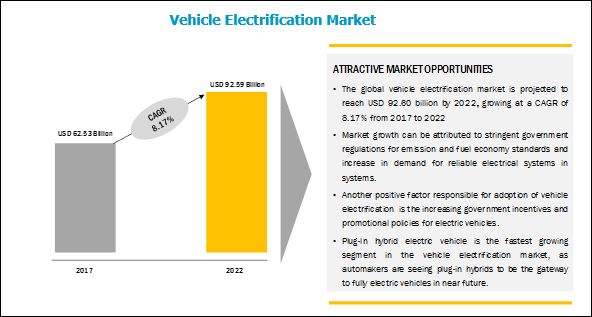The Vehicle Electrification Market is projected to grow at a CAGR of 8.17% during the forecast period, to reach a market size of USD 92.59 billion by 2022. The implementation of stringent emission norms and fuel economy standards globally as well as increasing vehicle production are driving the vehicle electrification market. Alternatively, the high cost of electric vehicles can undermine the demand for vehicle electrification.
According to the European Commission, CO2 emissions will be regulatorily limited at 95 g/km as an average value throughout the vehicle fleet by 2020. Also, the Corporate Average Fuel Economy (CAFE) regulations have set standards for vehicle fleets average for fuel economy. Till 2016, CAFE average of 35.5 mpg was followed, which will now change to 54.5 mpg with effect from 2017. Vehicle weight reduction is one of the preferred methods to achieve these targets and electrification of the conventional mechanical components is one of the ways to achieve the vehicle light-weighting. For instance, electric power steering, which is lighter than the hydraulic power steering, can benefit in terms of 2-4% improved fuel efficiency.
Alternatively, with an increase in electrified components, such as an electric water pump, electric oil pump, and an electric vacuum pump among others, there would be an increase in demand for high voltage architecture. Thus, further fuelling the demand for vehicle electrification.
Ask for PDF Brochure @ https://www.marketsandmarkets.com/pdfdownload.asp?id=224946587
The vehicle electrification market consists of vehicle electrification technology suppliers such as Robert Bosch GmbH (Germany), Continental AG (Germany), Denso Corporation (Japan), Delphi Automotive PLC (U.K.), and Johnson Electric (Hong Kong). The vehicle electrification components are supplied to major OEMs in the automotive industry such as Volkswagen (Germany), Toyota Motor Corporation (Japan), Honda Motor Co. Ltd (Japan), and others.
Demand-Side Analysis-
1 Rising Trend of Vehicle Electrification
2 Growing Demand for Hybrid and Electric Vehicles
Supply Side Analysis-
1 Stringent Emission and Fuel Economy Standards
Asia-Oceania: Largest vehicle electrification market in the automotive industry
Asia-Oceania is estimated to lead the vehicle electrification market, as the region represents countries such as China, Japan, South Korea, and India with the world’s highest vehicle production. The automobile industry is flourishing in this region, especially in South Asia. Additionally, Asia-Oceania has created hubs for automobile manufacturers and automotive component suppliers.
Stringent emission norms and fuel economy standards of these countries would help to create more opportunities for vehicle electrification. Countries such as China and India have plans to upgrade their emission regulations by 2020.
For instance, India is planning to skip BS V regulations by leapfrogging to BS VI. This is a positive development for the vehicle electrification market. Additionally, the demand for electric and electronic components in vehicles helps to increase the trend of vehicle electrification.
Make an Inquiry @ https://www.marketsandmarkets.com/Enquiry_Before_Buying.asp?id=224946587
The market for plug-in hybrid electric vehicles (PHEV) is estimated to witness the fastest growth in the vehicle electrification market
Plug-in hybrid electric vehicles are projected to lead the vehicle electrification market, in terms of value, during the forecast period. Automakers are seeing plug-in hybrids as the gateway to electric vehicles. Government tax incentives and state rebates have boosted the proliferation of plug-in hybrid vehicles. Asia-Oceania and North America are estimated to be the fastest growing markets for plug-in hybrid electric vehicles. Increasing charging infrastructure in North America is responsible for the shift from conventional ICE vehicles to PHEV. OEMs in this region have also invested a significant amount in the development of vehicle electrification. This would also drive the demand for plug-in hybrid electric vehicles.



